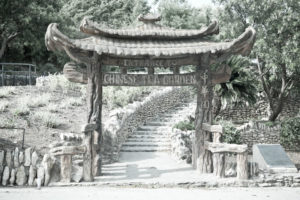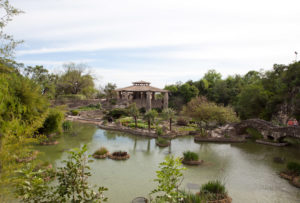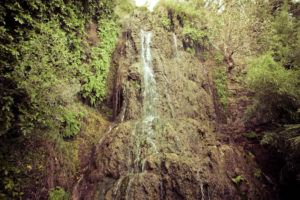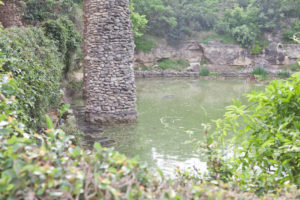Japanese Tea Garden San Antonio Texas
I found this tea garden searching on Google for some fun places to go while in San Antonio and I thrilled to say this was definitely a hit. Actually connect to the San Antonio Zoo by a long dirt walkway it’s an incredible beautiful place.
You first walk towards an archway with a plaque that explains the history of the tea house and a worthy read. You walk up a few steps then you are in awe of a rock pillared pagoda, it’s amazing the rocks all piled on top of each other making the pillars as well as the canopy of the pagoda.
You barely get a moment to take it all in when you look beyond the pagoda to the “sunken” gardens and you are just at a loss of words, it’s so beautiful. A waterfall off in the distance catches your eye as you admire the beauty and it’s not even spring or summer yet and the flowers are not in bloom. There are a lot of Koi fish waiting for you as you walk over the bridges you can see the plants starting to bloom, the water lilies are being planted and life is surely coming to this amazing place.
I could imagine the most splendid wedding there, small intimate and breathtaking.
I’m glad we took the time out of our travels to visit and I’ve enjoyed sharing the pictures with you, if you get near San Antonio, please visit. We were too late for tea in the lunch area but I am sure it’s fantastic.
***Below you will find the history of the Japanese Tea Garden, the reason the name changed to Chinese Te Garden and why the original creators of the garden were forced to leave.
In 1899, the San Antonio Water Works Company, through its president, George W. Brackenridge, donated 199 acres to the City of San Antonio for a public park. This tract comprises the largest portion of the park that today bears Brackenridge’s name. After some improvements were made, the park officially opened to the public in 1901. At that time, there was still an operating rock quarry west of the park on City-owned property. The quarry had been leased by the City to stone cutters since the mid-1800s and in 1880, Alamo Portland and Roman Cement Company (later called Alamo Cement Company) began to use the quarry. When the company needed rail lines to expand production, it purchased a new site and closed its Brackenridge Park operation in 1908.
Between the quarry and San Antonio River to the east was an 11-acre tract of land owned by Mrs. Emma Koehler, widow of Pearl Brewery owner Otto Koehler. Mrs. Koehler donated this land to the City in 1915 for a public park and its location immediately adjacent to the abandoned quarry posed a challenge for City Parks Commissioner, Ray Lambert.
Lambert ultimately came up with the idea of a lily pond which eventually became the Japanese Tea Garden. With plans from his park engineer and no money, Lambert was able to construct the Garden. Between July 1917 and May 1918, Lambert used prison labor to shape the quarry into a complex that included walkways, stone arch bridges, an island and a Japanese pagoda. The garden was termed the lily pond, and local residents donated bulbs to beautify the area. The City nursery provided exotic plants and the City Public Service Company donated the lighting system. The pagoda was roofed with palm leaves from trees in City parks. When completed, Lambert had spent only $7,000. In 1919, The American City magazine reported that “the city of San Antonio has recently completed a municipal lily pond and a Japanese garden which we believe are unique.”
Lambert continued to improve the garden, and in 1920, at the base of the old cement kilns, a small village of houses was constructed, termed by the San Antonio Express as “another dream of the artist of the Lily Pool, Ray Lambert, Commissioner of Parks.” The village was designed to be a tourist attraction for the manufacturing and sale of Mexican arts and crafts and an outdoor restaurant. It is not known how long the village operated. At the entrance to the gardens, artist Dionicio Rodriguez replicated a Japanese torii gate in his unique style of concrete construction that imitated wood.
In 1926, at the City’s invitation, Kimi Eizo Jingu, a local Japanese-American artist, moved to the garden and opened the Bamboo Room, where light lunches and tea were sold. After Mr. Jingu’s death in the late 1930s, his family continued to operate the tea garden until 1942, when they were evicted because of anti-Japanese sentiment during World War II. A Chinese-American family operated the facility until the early 1960s, and it was known as the Chinese Sunken Garden. In 1984, the area was rededicated as the Japanese Tea Garden in a ceremony attended by the Jingu’s children and representatives of the Japanese government.
In recognition of the Tea Garden’s origin as a rock quarry that played a prominent role in the development of the cement business, as well as its later redevelopment as a garden, the site is designated as a Texas Civil Engineering Landmark, a Registered Texas Historic Landmark, and is listed on the National Register of Historic Places.
The garden underwent a renovation beginning in May 2007 in which the ponds and waterfall were repaired, along with adding a recirculation system to provide a safe habitat for new Koi and aquatic plants. This phase, which cost $1,587,470, was a public-private partnership with the City of San Antonio, the San Antonio Parks Foundation and the Friends of the Parks. A grand reopening ceremony was held on March 8, 2008, which was attended by the Lambert family, descendents of Park Commissioner Ray Lambert, as well as numerous members of the Jingu family, including Mabel Jingu Enkoji, who was born in the Jingu House and lived at the garden as a child.
The San Antonio Parks Foundation contributed $100,000 toward the Master Plan for the Garden, as well as $800,000 toward the restoration of the ponds and waterfall. The Foundation continues to raise funds for on going revitalization of the Japanese Tea Garden.
Taken from: http://www.sanantonio.gov/ParksAndRec/Parks-Facilities/All-Parks-Facilities/Parks-Facilities-Details/ArtMID/14820/ArticleID/2912/Japanese-Tea-Garden





